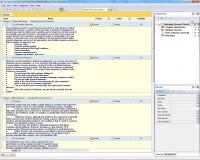|
Task Management Software |
 |
|
|
|
|
| |
|
 TESTIMONIALS TESTIMONIALS
|
|
"...This is an excellent program. I'm so glad that I stumbled on to this when researching for task management programs. Very low learning curv, quite flexible, and the price is right. Tried at least 20 other programs, either too complicated, too expensive, or poor documentation..."
Chad Lindsey -
Honolulu, HI
|
|
|
|
|
|
|
|
Marketing Research Checklist |
|
|
|
|
|
|

 |
Conducting marketing research campaigns helps businesses to get insight into their markets, reach target consumers and understand how to better sell and promote their products and services. This checklist describes the key steps of the process.
|
| Order 750 checklists in MS Word and PDF printable format at $49.99 USD only. |
BUY NOW!  |
1. Problem Identification.
- Set Research Objectives. Any marketing research is carried out because there is some business-related problem that requires a solution. When you make a decision on planning your research you need to define such a problem and set objectives for the research. For example, you want to launch a new product so you need to test your new market and find out if customers respond favorably or unfavorably to the new product. In this particular case, the problem is the new product launch while research objectives are to test the new market and identify customer preferences. Other examples of objectives are:
- Increase sales.
- Diversify existing supply.
- Better understand the target audience.
- Retain customers.
- Improve competitiveness.
- Conquer new markets, and so on.
- Set Success Measures. When the research problem is defined and objectives are set your next step is to determine success measures, or a set of metrics that help you figure out a solution to your problem. Success measures are based on the correlation between research expenses and net revenue. The key success measure is marketing Return on Investment (mROI). Try to answer these questions to define if your research is successful:
- Do you target the right customer audience?
- Do you meet your research objectives?
- How can you modify current research campaign to improve results?
- Do you use right research methods?
- What is the most effective lead generator for your campaign?
- What is your cost of customer acquisition?
- Can you say that your research helps you understand customer attitudes?
- When the research is finished can your business benefit from the results?
2. Method Selection.
- Surveys. Marketing surveys help you analyze sample groups of customers that represent your target market. There are several kinds of marketing surveys, including:
- In-person Survey: during one-on-one customer interviews conducted in high-traffic locations you can present or advertize a product and gather immediate feedback. This method is costly as it requires a considerable amount of labor force and finances.
- Telephone Surveys: although this method is less expensive it generally yields response rates of 50 to 60 percent. During a phone call you can ask questions and get immediate feedback. The problem is that it’s hard to convince customers to participate in phone surveys.
- Mail Surveys: this method is relatively inexpensive and allows reaching a broad audience. However, it produces a low return (a 15-% response rate). Today mail surveys remain cost-effective to small businesses.
- Online Surveys: this marketing survey method is the most inexpensive way to collect customer opinions and preferences. The problem is that it provides unpredictable response rates and unreliable data.
- Focus Groups. This method lets you share various question lists and questionnaires among a group of people to organize group discussions and use brainstorming techniques. The method provides valuable insights into customer attitudes yet it is expensive enough.
- Observation. It lets you observe customers in action (how they buy or use your product/service). Your respondents will give you a more accurate picture of customers' usage habits and shopping patterns.
- Field Trials. This method assumes that you place a trial product to test customer responses. It also allows you to make relevant product modifications, adjust prices, and improve packaging.
3. Data Collection and Analysis.
- Once you have chosen methods for conducting your marketing research, your next step is to start using these methods to collect data. During the data collection process you need to make sure that you gather relevant information from right sources. There are two possible data sources.
- Primary Data Source. It includes information (facts and figures) that you’ve gathered specifically for the purpose of making your current marketing decisions. Interviews, questionnaires, surveys are examples of the primary data source.
- Secondary Data Source. This source includes information that you’ve previously used in other marketing processes, campaigns and projects. It may also include some facts and figures gathered from external, independent sources. For example, you can use business reviews, spreadsheets, online publications, statistics and the like to collect information about your customers.
- Once the data collection process has yielded sufficient and relevant results you can start systematically reviewing and organizing your data into interpreted pieces of information helpful for making decisions and generating solutions. You can use such tools as statistical graphs, curves, spreadsheets, and pie-charts to analyze your research data and make conclusions.
4. Reporting.
- The final step in your research is to develop a report that covers results ...
| Order 750 checklists in MS Word and PDF printable format at $49.99 USD only. |
BUY NOW!  |
|





 |
CentriQS Tasks Management Solution 
Looking for multi-user task management software? Try CentriQS complete task management solution for planning, tracking and reporting tasks, projects, and schedules. Increase productivity of your small business or office by better organizing your employees' tasks and time.
 FREE Download CentriQS FREE Download CentriQS
|
|
|
|
|
|
|
|
|
|
CentriQS  -15% OFF -15% OFF |
All-in-one business management software
for small and midsize enterprises |
 |
|
|
| VIP Task Manager |
Multi-user project management software
to plan, schedule and track project tasks. |
 |
|
|
| VIP Checklists
|
More than 750 ready-to-use to-do lists
to plan your personal and business life |
 |
|
|
| VIP Team To Do List |
Professional task management software
to make and send team todo lists by email |
 |
|
|
| VIP Organizer |
Personal time management software
to organize time at home and at work |
 |
|
|
| VIP Simple To Do List
|
Simple and effective to-do list software
to plan daily chores, trips, wedding, etc. |
 |
|
|
|
|
|
|
|